► New 4xe version brings four-wheel-drive to Avenger
► Based on hybrid version and not the EV
► Orders to open before the end of 2024
Jeep has finally confirmed the introduction of a four-wheel-drive Avenger, which has been promised since the initial reveal of this electric crossover.
But rather than creating an electric four-wheel-drive model in what would have been a first for Jeep, it is instead relying on the recently introduced mild-hybrid version to create this 4×4.
What’s new about this Avenger 4xe?
Unlike Jeep’s other 4xe-badged models – the Compass and the Renegade – the Avenger won’t be a plug-in hybrid, but rather a mild-hybrid setup instead.
It’s essentially an extension of the e-Hybrid version already on sale, using a 134bhp 1.2-litre petrol engine widely found in the Stellantis group, but paired with two small electric motors producing 29bhp each. There’s one on either axle, and is capable of sending torque to the rear wheels, allowing four-wheel-drive.
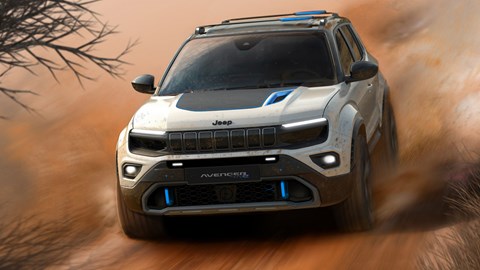
Despite the mild-hybrid’s small battery, Jeep says its ‘power looping’ technology can guarantee all-wheel-drive regardless of the level of battery charge. While we’re sceptical of the level of off-roading prowess that this relatively small mild-hybrid setup can achieve, the firm promises a ‘confident driving experience across the most challenging diverse terrains’. This 4xe model is expected to go on sale before the end of 2024.
This 4xe model will sit alongside a 99bhp 1.2-litre mild ‘e-Hybrid’ model that’s already on sale. In terms of electric driving ability, Jeep says the e-Hybrid potter around town for 0.6 miles at speeds of up to 18mph before draining its battery. That doesn’t sound like much, but it’s just enough to trim the car’s CO2 emissions down to 111g/km of CO2, which is 10g/km lower than the pure petrol model. Jeep also claims the powertrain can return up to 55.3mpg.
Hasn’t Jeep shown a four-wheel-drive Avenger before?
Jeep teased the 4xe with the Avenger 4×4 Concept at the 2022 Paris Motor Show. At the time, the company’s former CEO, Christian Meunier said: ‘We couldn’t help but wonder, what would happen if we injected the Jeep brand’s four-wheel-drive electrified capabilities into a compact package, while retaining the brand’s unique design language, capability and personality?’
Jeep only showed the tough visuals, keeping the finer details of the 4xe powertrain under wraps. The 4×4 concept featured chunkier tyres, prominent tow hooks, extra lights and thicker body cladding. It also previewed a new roof rack system, with belts designed to compress luggage.
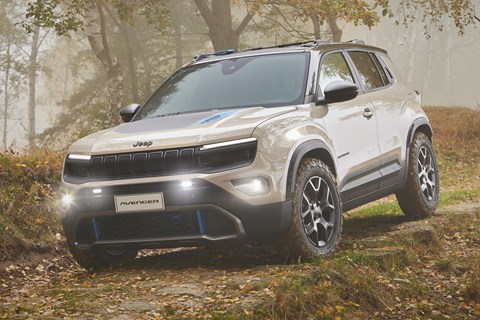
The 4×4 concept’s approach angle means it can cope with a 21-degree ramp and depart a 34-degree obstacle without snagging the overhangs. That’s an improvement on the regular Avenger’s capability, as well as taking ground clearance above 200mm.
Jeep says the 4xe will delivers the brand’s trademark off-road prowess – and insiders say that even if the front wheels have zero grip on a 20-degree incline, the electric-powered rear axle will be able to comfortably accelerate up the car up and out of trouble.
What about the pure petrol model?
The pure-petrol Avenger features the same 99bhp 1.2-litre petrol engine as the mild hybrid model, minus the automatic gearbox and electrical gubbins. In its place – driving enthusiasts rejoice – is a six-speed manual transmission. You don’t sacrifice too much fuel economy by ditching the hybrid system, either. Jeep claims the petrol Avenger can return up to 51mpg.
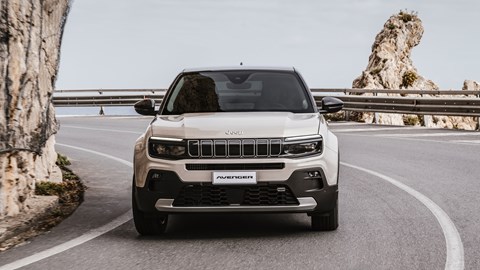
The first cars hit UK roads before the end of 2023, but were only be available in limited numbers – at least initially. At first, Jeep said it would bring just 500 cars to the UK in 2023, though it’s likely to introduce far more throughout in 2024 amid weakening EV sales. Prices for the petrol version start from £23,600.
Tell me more about the baby Jeep
The Avenger was designed to be a pure-electric SUV that could get more young people – especially females – to embrace a brand traditionally associated with macho outdoor types. It was also the company’s the first-ever electric vehicle. It’ll be followed by plenty more: Jeep will have four electric cars on sale in Europe by 2025 and will be all-electric in Europe by 2030.
It shares some underpinnings with Stellantis stablemates such as the Peugeot 2008, but the e-CMP2 platform has been heavily modified, and the bodywork and cabin are entirely new. An Alfa Romeo spin-off, called the Milano, will follow in 2024 and be built at the same factory in Tychy, Poland, where the Fiat 500 is also produced.
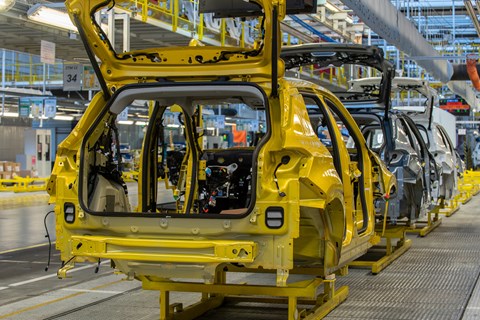
Jeep’s Head of Global Design Ralph Gilles said: ‘When I first started here, 31 years ago, we only had three name plates. A niche brand, not thinking in a global way. At Stellantis, the pace of change is incredible. Jeep still has a small-town dynamic, with this incredible company behind us.’
His brief from Meunier? ‘I want a fun, boxy Jeep that’s all electric.’ In turn, Gilles briefed Daniele Calonaci, European design chief: ‘Even without a badge, you need to know it’s a Jeep.’
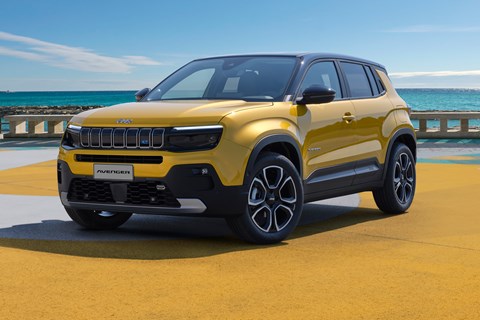
The Avenger was designed in Italy, making the first Jeep to be designed outside the US (although studios from around the world have had design input in the past). And it doesn’t just look like a Jeep – even the EV has the brand’s traditional off-road ability too, despite being front-wheel drive.
It comes with hill descent control and six driving modes: Eco, Normal, Sport, Sand, Mud and Snow. The ground clearance is 200mm or more, depending on spec, with a 20-degree breakover angle, 20-degree approach angle and a 32-degree departure angle. Most Avengers won’t ever see the dirt, but that capability and ruggedness will make them well suited to battling kerbs, speed bumps and tricky multi-storey ramps.
What was the thinking behind the design?
Jeep’s former CEO Christian Meunier says the Avenger is true to the company’s core pillars of freedom, adventure, authenticity and passion. ‘It’s not marketing bullshit. Whenever we have a conversation about product, it has to be robust, and we like to convey that with the design of the product. There’s no fake stuff on a Jeep.’
Meunier also acknowledges that Jeep is under-performing in much of Europe. Italy is its biggest market by some way, with 10 per cent SUV market share, compared to one or two per cent in most other countries.
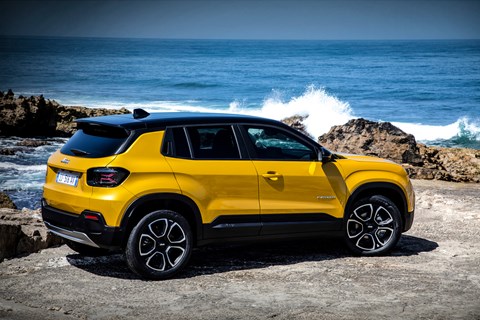
‘It’s disappointing. Why are we so low? There have been issues with offering the wrong powertrains [lacking diesels when they were in demand, then being slow with hybrids]. With the Renegade 4xe we are starting to get momentum. The vehicles are getting more appropriate for Europe, for daily use and a lifestyle machine for the weekend.’
Jeep has certainly paid more than a passing tribute to its heritage with the Avenger. Its shoulder line is from the firm’s cornerstone product, the Willy’s Jeep of 1941, as are the trapezoidal wheel arches. The floating C-pillar is from the Compass and Grand Cherokee. The grille has the family’s seven-slot look but is in fact closed on the electric models (with cooling air coming in under the front bumper).
Inside, there’s a strong horizontal line across the dashboard and plenty of oddment stowage, including a simply massive storage bin in the centre console.
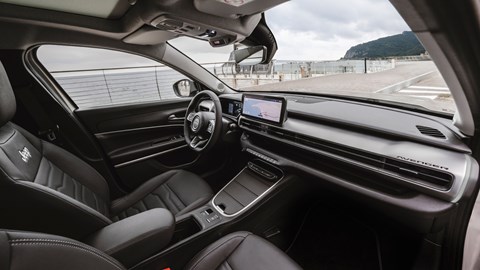
In the middle of the dash is a 10.25-inch infotainment screen and, in front of the driver, digital gauge cluster of 7.0 or 10.25 inches, depending on spec. The touchscreen supports Apple CarPlay and Android Auto as standard, which is good because Jeep’s built-in sat-nav system costs extra.
There’s a choice of seven body colours, and a variety of dealer-fit body graphics for the roof, bonnet and grille. Wheel sizes range from 16 to 18 inches.
Tell me more about the EV’s specifications
It features a single electric motor, with an output of 154bhp and 192lb ft of torque, powering the front wheels. The battery measure 51kWh and is divided into two cell banks that sit under the front and rear seats, to allow some extra room for the rear passengers’ feet.
Jeep says that, under WLTP conditions, the Avenger has a maximum range of 248 miles on mixed roads or 342 miles if you’re just dithering around town. It also offers support for 100kW DC rapid charging which can charge the battery from 20 to 80 percent in 24 minutes.

It measures 4084mm long and, with its short front and rear overhangs, the Avenger is the smallest Jeep, slotting into the range under the Renegade. Its boot space is 380 litres and it weighs 1541kg, of which 340kg is the electric powertrain.
Does Jeep think it’ll work?
Globally, Jeep has enjoyed a four-fold sales increase since the start of the decade – up from 400,000 cars a year then to 1.2-1.5 million now.
The success of the Wrangler and Grand Cherokee hybrids in the US shows Jeep that buyers are happy with electrification – and Jeep is so confident that it’s bring the Grand Cherokee to the UK in 2024, after delays caused by supply chain issues. A spokesperson for the brand said: ‘It’s a big opportunity. A 4xe Jeep is a better Jeep.’
Jeep’s new-look line-up will also include a Range Rover Sport rival based on the recently revealed Wagoneer S concept, as well as a rugged Wrangler-style EV called the Recon. The fourth electric Jeep has not yet been revealed.